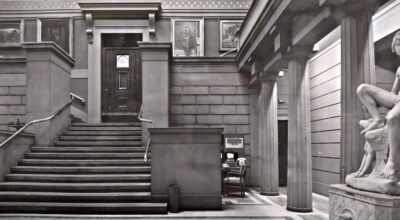Each year the gallery is gifted a sum to acquire artworks from The Manchester Contemporary Art Fair.
The Manchester Contemporary Art Fund was set up by one of our trustees, Thom Hetherington, CEO of Holden Media who initiated and delivers each Manchester Art Fair. The Fund’s members are made up of local businesspeople and entrepreneurs who are passionate about their city and its cultural heritage. The membership seeks to support rising artists, providing them with a platform through which to achieve critical acclaim and greater popularity by having their work in a public institution. The fund is crucial to the Gallery. At a time of scarce public funding and competition for grants, it’s a rare opportunity to bring contemporary work into the collection and support the arts ecology of the city.
The initiative has been shortlisted for two major awards this year. As Thom explains:
“We’ve rapidly become one of the largest regional philanthropic art funds, and to be shortlisted for the prestigious 2022 Achates Philanthropy Prize and the Manchester Culture Awards is a great honour and testament to our impact. But with Manchester Art Gallery’s 200th anniversary looming we will not be resting on our laurels; we have great plans to ensure the fund will continue to grow and develop to provide a fitting celebration of that milestone.”
If you recognise the importance of the arts, want to give something back, leave a mark and be part of our 200th anniversary celebrations you can sign up here Art Fund | The Manchester Contemporary.
Since 2017 the gallery has been able to acquire 14 works. A number of these are currently on show in our collections galleries. When selecting artworks, the curators consider a number of criteria including how a work connects to our collection, our vision and our collecting policy and this year we were able to purchase four works, which are all very different:
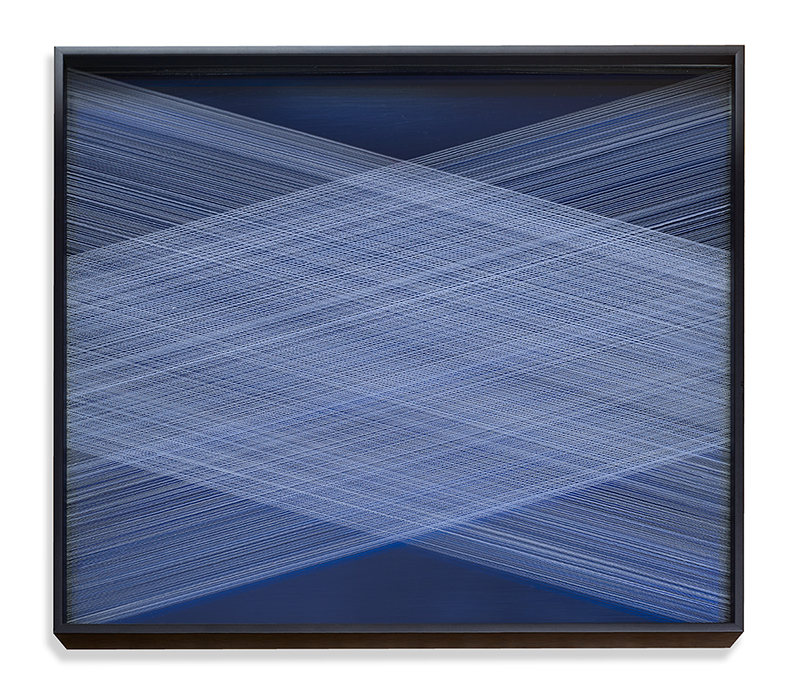
Bread and Water 2
Mary Griffiths
stainless steel, blue Perspex, inscribed plain Perspex
30 x 35 cm
Mary Griffiths’ practice begins with drawing and the close observation of urban, rural and industrial ecologies and architectures. Rapid figurative drawings are at the root of her abstract works, which are then developed in the studio as precise, repetitive lines in graphite, ink, print and paint. These geometric lines are inscribed singly and uniquely over many weeks, using basic hand tools, onto different surfaces.
This particular work uses coloured Perspex and stainless steel, which results in a mirror like finish: “I realised that I could cut a drawing directly into plastic. I then began to play around with coloured Perspex and stainless steel. The latter acting as a mirror and giving some of the depth that my (earlier) polished graphite drawings have. Eventually, I made three drawings in blue, red and orange. The three layers inside Bread and Water 2 are all separated by about 3mm.
The colour of the work was dictated by the standard colours of Perspex available, but it also suggests the cosmological – a theme that runs through my work. The places I render through abstraction are often quite modest working class rooms that connect through life stories and history to the vast realms of the cosmos. I call this the Everyday Cosmic”.
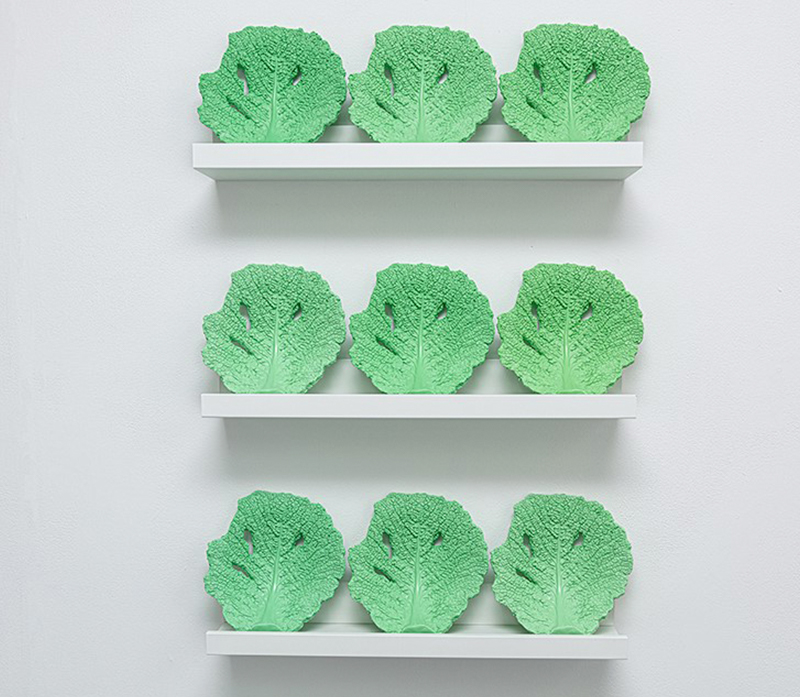
Cabbage 2022
Charlotte Dawson
Jesmonite, pigment and wax
21 x 21 x 5 cm each
(purchased 3 from the set of 9)
Charlotte Dawson explores overlooked objects that become important cultural and personal touchstones, often using the form of commonplace homeware. These sculptures settle somewhere between sculpture, functional object, ornament or souvenir. They also connect to the gallery’s 18th C ‘Cabbage Ware’ ceramics, still life paintings and more recent Nordic acquisitions that reference original and rarefied objects -v- mass-produced objects.
Charlotte sculpts a singular object in clay. From this original a silicone mould is created. Using this mould multiple pieces can be cast in Jesmonite*. The mould turns the unique object into a mass produced piece, utilising repetitive action to produce a uniform object. Charlotte explains, “Despite this ‘uniformity’, the individual casts hold within their own physicality the traces of my hand. My fingerprints are left embedded in the clay and tape marks left in their sides from the sweet tub walls of my makeshift moulds. Each cast plate, although identical in shape also has a variation of pigment”.
*A composite material made of a liquid and a powder which, when combined, creates a resilient material, almost like resin.
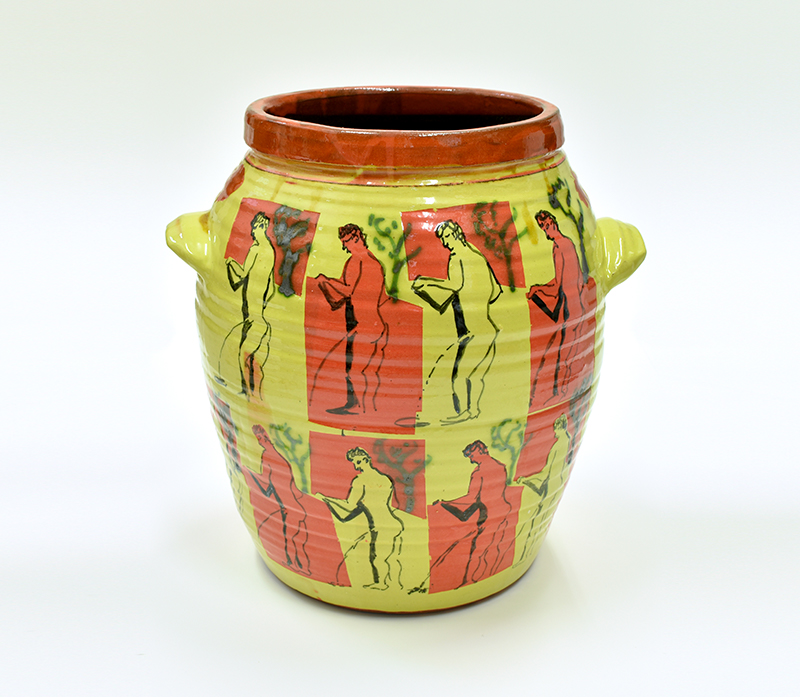

Jar (Dandelions, after DH Lawrence) 2021
Simon Bayliss
Terracotta, coloured slips, oxides, clear and honey glaze
38 cm (height)
This work has strong connections with the gallery’s own collection. It references the tradition of studio pottery from our Craft & Design collection, as well as pieces by Grayson Perry through the use of subversive imagery on a traditional ceramic form and the more historic use of the male figure on Greek pottery. Jar is loosely based on the shapes and ethos of 20th century studio potters, traditional slipware and Japanese stoneware. However, his imagery draws on issues around sexuality, which he uses in a way to queer the tradition.
The imagery is based on a DH Lawrence watercolour, Dandelions.
Bayliss explains, “it’s an odd painting with an odd title – erotic and voyeuristic, and also something that speaks of freedom and connection to nature. I particularly like the shadow on the wall. It’s a motif that I used on a harvest jug I have also made and I use it partly as a way to quietly queer the tradition of slipware and studio pottery.
Another way of queering the tradition, is through the use of colour. Traditional studio pottery is notoriously ‘brown’, and even traditional slipware has a very limited pallet of mostly warm honey yellows. I mostly use commercial stains to make the slips (liquid clay poured over the surface) and the use of citrus green is my way of subverting that tradition”.
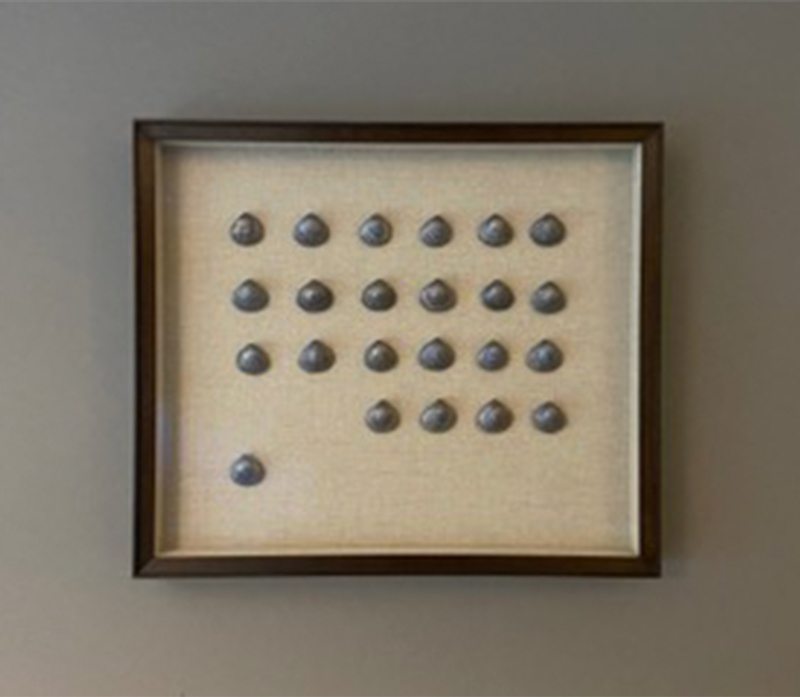
Sea Fruit
Jamie Holman
A series of 23 hand cast cockles in Victorian lead, presented in a wall mounted case
44.5 x 38.2 x 4.6 cm
This work was created to commemorate the 2004 Morecambe Bay tragedy that took the lives of 23 Chinese workers. On this night only 1 man was brought black alive from the water. 1 man remains lost to the sea. One cockle remains displaced from the group representing Dong Zin Wu who is still missing. The title is taken from a translation in a Chinese news article on the disaster, in translation the French name for the foodstuff, Fruit de Mer, was used.
In memory of this tragedy 10% of the sale of all works in this series are donated to the RNLI, Morecambe Lifeboat Crew Fund to support the ongoing life-saving work of those who fought bravely through the night to save the life of one, and return the bodies of those who died to their families and their country.
Thank you to all The Manchester Contemporary Art Fund members this year: Christian Anderton & Sarah Maskell, Lisa Ashurst, Jo & Tom Bloxham, Netanya Clixby, James & Katie Eden, Mark Garner, Mark & Toni Hawthorn, Thom Hetherington & Sophie Helm, Alison Loveday, David Blake & Lucy Noone Blake, Jeremy & Jane Roberts, Howard Ratcliffe & Melissa Ratcliffe, Jon Sharples and Martyn & Val Torevell.
Look out for these works around the gallery in the coming months!







